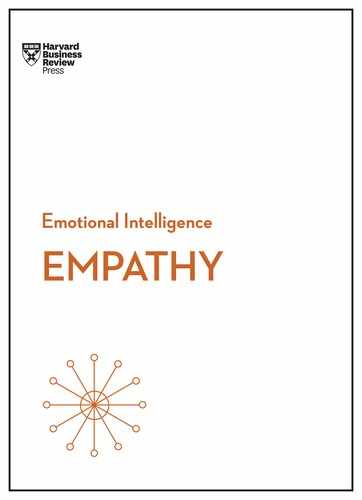Index
abductive reasoning, 77
Blackboard, 84
Cannon, Patrick, 65–66
compassion
analyzing problems from a perspective of, 128–130
controlling your response to a mistake, 21–22
creativity’s connection to, 19–20
cultivating through mindfulness, 124–126
empathy versus, 121–122
forgiveness and, 23–24
influences on levels of, 54–56
lessons from the Dalai Lama, 126–128
loyalty’s connection to, 17–19
outcomes of compassionate management, 23–24
place in the business world, 122–124
taking the employee’s perspective and, 22–23
ways to respond to an employee’s mistake, 16, 21–24
willingness to trust and, 18
compassion fatigue, 101–102
Cuddy, Amy, 21
emotional self-management, 46–48
empathy
compassion versus, 121–122
controlling when appropriate, 10–11
developing, 6–7
influence of power on (see power and empathy)
leaders’ empathy gap, 57–58
levels of compassion and, 54–56
limits of (see limits of empathy)
product design and (see product design)
psychological truths that reduce, 56–57
role in meetings, 44–46
Facebook security
diverse disciplines used in, 95–96
empathetic language use, 95
empathy incorporated in, 94–95
human element in online security, 89
Focus: The Hidden Driver of Excellence (Goleman), 48
Folkman, Joseph, 29–40
Force for Good: The Dalai Lama’s Vision for Our World (Goleman), 120
Ford Motor Company, 99–100, 114
Frog Design, 84
Goleman, Daniel, 1–11, 48, 117–130
Keltner, Dacher, 64
Kolko, Jon, 71–85
Lee, Fiona, 20
limits of empathy
concept of empathy in organizations, 100
emotional toll of empathy, 101–103
erosion of ethics and, 106–109
giving employees breaks from empathy, 111–113
making empathy less of a sacrifice, 110–111
preferential empathy, 105–106
splitting up work demands and, 109–110
talking with people about their experiences and, 113–114
zero-sum problem in empathy, 103–106
LinkedIn, 83
listening
analysis of listening skills data, 32–33
good listeners’ characteristics, 33–36, 40
levels of, 37–39
poor listeners’ characteristics, 35
presumed qualities of a good listener, 31–32, 40
loyalty
connection to experiencing compassion, 17
impact of an angry response on, 18–19
Luu-Van, Melissa, 87–96
Martin, Roger, 77
McDonnell, Mary-Hunter, 51–59
McKee, Annie, 41–48
McLaren, 113
meetings
emotional self-management’s role in improving, 46–48
empathy’s role in improving, 44–46
importance of happiness at work, 43
neurological link between feelings and cognition, 47
mindfulness, 125–126
Mindwise (Epley), 113
MyEdu, 73
Nordgren, Loran, 51–59
Orrb Technologies, 113
Ovans, Andrea, 117–130
power and empathy
applying empathy in meetings, 44–46
point where a person begins to abuse power, 65–66
response to an employee’s mistake and, 16, 21–24
shift in behaviors when someone is promoted, 8, 63–65
ways to avoid abusing power, 67–69
arriving at a value proposition, 80–82, 83
articulating the “what-if” opportunity, 80, 81
asking “why”-oriented questions, 76–77
chronicling the participants’ collective voice, 75
empathetic research process, 83–84
insight statements creation, 77–78, 79
master and apprentice relationship in, 74–75
qualitative research use, 74, 84–85
result of the development process, 82–84
shift in product management approach, 73
synthesizing research into insights, 76–78
telling stories about the product, 82
Riess, Helen, 6–7
Ruttan, Rachel, 51–59
self-awareness
cognitive empathy and, 5
emotional intelligence and, 3
facilitation of compassion and, 22
meditation and, 21
using to avoid abusing power, 67–69
Seppala, Emma, 13–24
Singer, Tania, 6
Solomon, Lou, 61–69
stress
compassion fatigue and, 101
creativity and, 19–20
forgiveness’s impact on, 23
influence on a response to a mistake, 16
value proposition in product design, 80–82, 83
Van Meter, 113
Waytz, Adam, 97–114
Zenger, Jack, 29–40
